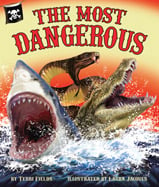Alignment to Standards for DC

| Grade | Number | Standard |
|---|---|---|
| 1 | SC.1.4. | Different types of plants and animals inhabit the Earth. |
| 2 | G 2.1.1. | Understand how maps and globes depict geographical information in different ways. (G) |
| 2 | SC.2.6. | Plants and animals have structures that serve different functions in growth, survival, and reproduction. |
| 2 | SC.2.6.1. | visible, external features of plants and animals and describe how these features help them live in different environments. |
| 2 | SC.2.7.1. | Observe and describe how animals may use plants, or even other animals, for shelter and nesting. |
| 2 | SC.2.8. | Many different types of plants and animals inhabit the Earth. |
| 2 | SC.2.8.1. | living things are found almost everywhere in the world in habitats such as the oceans, rivers, rain forests, mountain ranges, arctic tundra, farms, cities, and other environments. Recognize that some habitats are extreme, such a |
| 2 | SC.2.8.2. | the numbers and types of living things can vary greatly from place to place. |
| 2 | SC.2.9.1. | people are more like one another than they are like other animals. Each type of animal is more like its relatives (family) than it is like the animals of other types (or families). |
| 3 | SC.3.5. | Plants/animals classified by the physical characteristics that they share. |
| 3 | SC.3.5.1. | living things can be sorted into groups in many ways using various properties, such as how they look, where they live, and how they act, in order to decide which things belong to which group. |
| 3 | SC.3.5.2. | Explain that characteristics used for classification depend on the purpose of the grouping. |
| 4 | SC.4.7.2. | Observe and recognize that some source of energy is needed for all organisms to stay alive and grow. |
| 5 | SC.5.8. | Many characteristics of an organism are inherited from the parents, but others result from the influence of the environment. |
| 5 | SC.5.8.2. | List some characteristics of plants and animals that are fully inherited (e.g., form of flower, shape of leaves) and others that are affected by the climate or environmental conditions (e.g., browning of leaves from too much sun, language spoken). |
| 5 | SC.5.9.7. | Recognize that some behaviors are instinctive (turtles burying their eggs) and others learned (wolfês hunting skills). |
| K | G K.1. 2. | Demonstrate familiarity with what a map is and what a globe is. (G) |
| K-2 | G K-2.1. | Students use map and globe skills to determine the locations of places. |
| K-2 | H K-2.3. | Students distinguish fact from fiction. |
| K-2 | H K-2.4. | Students use nontext primary and secondary sources, such as maps, charts, graphs, photographs, works of art, and technical charts. |